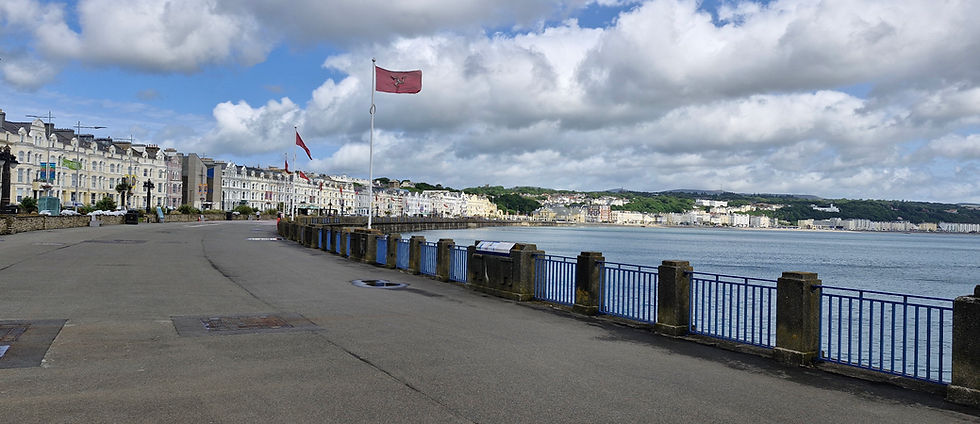Chambers at Large in the Isle of Man (1): Douglas, the capital city.
- Amelia Chambers
- Jul 14
- 4 min read
Updated: Jul 27
Deciding where to go on holiday in the height of summer (June/July) needs careful thought. I didn’t want to go somewhere too hot, nor too cold, nor too far away. I’ve toured Ireland, and most of the UK, except the islands, therefore the Isle of Man caught my attention. On doing a little research I found out it was not named after the male of the species, but the Celtic god of the sea Manannan, and the island is steeped in Celtic, Viking and Victorian history. Knowing that sealed the deal.

I booked a stay in the Regency Hotel on the Promenade of Douglas, the capital of the island, and once settled in my luxury room I decided to make my first port of call the Manx Museum. Once a hospital this is where the history of the island unfolds.

On entering the museum I encountered a skeleton of a Giant Deer dating back to the Ice Age (11,500 years ago) making me realise life on the island goes back centuries. Human habitation however dates back to 6500BC as many utensils made of flint, a stone found copiously across the island, have been found and are on display.

The Celts and the Vikings traded with coins, the first currency of the island, and these can be seen alongside large swords. I tend to think of Vikings violently pillaging rather than happily paying, but every day is a school day.

Other exhibits led me through the centuries but there was an exhibition dedicated to Archibald Knox, a Manx nineteenth century artist and designer whose work, based very much on Celtic art, were utilised by Liberty of London.

The influence of the Victorians can be seen in the architecture in Douglas. I walked along the promenade nearly every day, forgoing the use of a tram pulled by magnificent horses.

The Promenade is lined with Victorian four storey houses, many now hotels and apartments, and nearing the harbour beautiful gardens allow tourists the chance to rest their legs.

The municipal building and the railway station where I caught the steam train (more on that in a subsequent blog) are fabulous examples of Victorian architecture, but the port is far more up-to-date, filled with sailing boats and more modern eateries.

The Gaiety Theatre is a fine throwback to Victorian times and a statue of the comedian Norman Wisdom sits outside a hotel next door.

Statues of the Gibb brothers, better known as the pop group, the Bee Gees, stand looking towards the town near the harbour. They were born in the city in the mid 1900s, like my good self.

Behind them, just out to sea is a castle which looks as if it is made of sand. This is the Tower of Refuge which was immortalised in a poem by William Wordsworth. Having witnessed too many ships wrecked on the rocks near the harbour Sir William Hillary, the founder of the RNLI and a resident of Douglas, proposed a sanctuary for those tossed into the sea.

The island is famous for its TT Race, when motorcycle racers and enthusiasts course around the roads of the island every June. This race was the background to a 1935 film called No Limit starring George Formby and featured the local riders as extras. A statue of George Formby playing his ukelele stands near a memorial square, quietly set back from the main shopping area, where plaques relate to those who have served.

A walk along the promenade reveals a great deal of recent history. There is a clock tower, a feature of many Victorian towns, and a memorial to those who died in the two world wars.

I learned that the Isle of Man was where several internment camps were set up during the world wars, one in Douglas. There is nothing left of the tented encampment which housed over 3000 internees at one point, but I was struck by the nomenclature of one street: Switzerland Road, which was near the camp. Make of that what you may.

At the other end of the promenade, near the tramway station, is the house where the Sophia Goulden resided in her retirement. She is the mother of Emeline Pankhurst the famous suffragette. Sophia was born on the island but spent much of her life with her children and husband in England.
I was quite taken aback by the amount of history the city of Douglas offered, although one woman I spoke to on the bus cynically commented, “they’d put up a statue or plaque of anyone remotely famous who visits the island.”

Well, perhaps it’s better to celebrate a little of the history of an area, rather than leave it long forgotten. I certainly enjoyed discovering who lived in Douglas and what had happened in the past and I’m glad I started in the Manx Museum as it gave me a taste of what else was on the island to explore. To discover more, please read my next two blogs!
***
My next blog features the towns of Peel and Castletown. Both are lovely and have castles. Please click on the link to learn more:





Comments